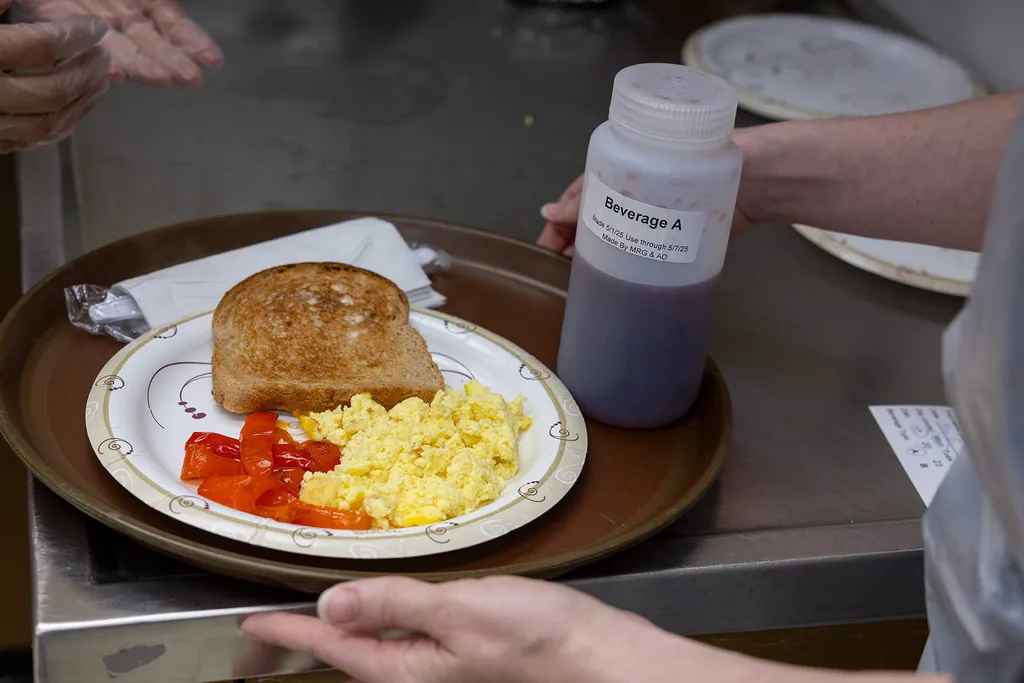- May 14, 2025
- By John Tucker
An alarm bell dinged, and Fernanda Sato dashed to the oven to remove a steaming tray of eggs. The University of Maryland master’s student was preparing breakfast in a campus kitchen for a half-dozen people dropping off samples from previous meals—in a manner of speaking.
Nutrition and food science students with UMD’s College of Agriculture and Natural Sciences are conducting an experiment on 24 participants, anchored by a typical American diet: egg and cheese croissant sandwiches, flour tortillas and crackers, for example. Because the menu largely eschews fruits, fiber and whole grain, it’s not the gold standard of nutrition, and that’s the point.
The meals lack catechins, a natural antioxidant chemical found in certain foods and beverages like apples, fava beans, sweet potatoes, blackberries, dark chocolate, green tea and red wine and thought to support heart health. The researchers want to confirm that premise, but they also suspect that only some eaters reap the biggest nutritional rewards of catechins, and they want to know why.
During a testing period that ended last week, participants hewed to low-catechin diets for three days, but half consumed catechin-rich cranberry-apple juice throughout the period while a control group drank a placebo drink made with sugars and artificial flavors and coloring.
Before and after the regimen, each participant submitted stool and urine samples. In the coming months the UMD team will probe the now-frozen specimens, looking for biomarkers of catechin digestion—a good sign—and compare it to participants’ blood pressure and body composition.
“Some people’s gut bacteria can metabolize the catechins to a greater extent so that they’re absorbed into the bloodstream, as opposed to, forgive me, just pooping it out," explained Associate Professor Margaret Slavin, who is leading the UMD study, funded by the U.S. Department of Agriculture.

After eating their on-campus breakfasts, participants left with freezer bags packed with low-catechin lunches, dinners and snacks prepared by UMD students in Slavin’s lab. Last Monday’s menu included turkey and cheese wraps, soybean nuts and meatloaf, mashed potatoes and glazed carrots. (Each participant spent one week in the intervention group and one week in the control group.)
Recruited through campus flyers offering cash compensation, most participants appeared to be students, though Slavin didn’t ask. After gathering data about their typical diets, her team devised a menu with similar foods.
Last Monday, Sato arrived at the industrial-size kitchen lab in Marie Mount Hall at 6 a.m., donned an apron and hairnet and began prepping breakfast. After graduation she plans to launch a career as a clinical dietitian for hospital patients with diabetes, cardiovascular disease and other health issues, assessing their nutrition status and recommending diets.
After the eggs had been scrambled and baked twice, Sato removed them from the oven and took their temperature—“185 degrees, we’re good,” she said—and passed the tray to another student who measured 120-gram portions into serving cups.
In an adjacent kitchen Nora Baustian, a second-year doctoral student, filled each participant’s take-home freezer bag, including instructions on when to drink the beverages. (For the intervention group, spreading catechin consumption throughout the day increases potential absorption.)
Shortly after 8 a.m., Baustian carried a platter of eggs, roasted peppers and buttered toast into a classroom doubling as a dining room and served it to Tereza Varejkova, a UMD economics doctoral student who joined the study in part because of her interest in nutrition. There was also a personal benefit, she said: “It’s nice not to think about cooking.”
On the first day and day after the diet, participants dropped off their stool and urine samples, which will eventually be shipped out for lab analysis. Slavin’s team will break down the data in hopes of publishing its findings next year.
The study grew out of an earlier data collection phase starting in 2023, when 180 people consumed a soy-based snack that distinguished them as either “producers” and “nonproducers” of catechin-related metabolites. A mix of 24 participants moved on to the current study.
The results could help dietitians personalize diets based on microbial makeup. If someone knows their gut can metabolize catechins, they could consume foods and beverages with higher levels. For other people, scientists might find ways to change their microbial composition or develop metabolite supplements, Slavin said.
“Right now, nutritionists give blanket advice to consume certain food groups, like getting plenty of vegetables and fruits—this is valid based on what current evidence says,” said Slavin. “But in the future, if we know that some people get more health benefits from certain foods, we could better target our recommendations to meet their individual needs.”
